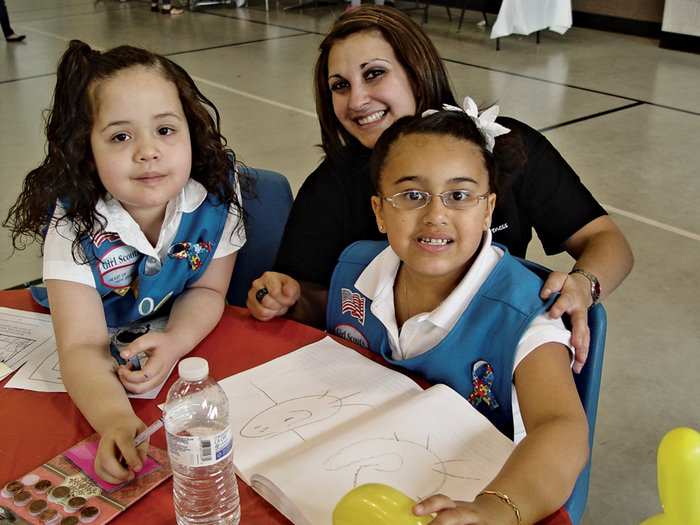“I’ve been a Daisy for 199 years,” six-year-old Jaiva Johnson said, dressed in her bright blue Daisy Scout sash, before dissolving into a fit of giggles at the Pavilion Gym in Union City on April 28. “I like to play in balloon water fights, I like to play tag with my friends, I love to play hide and seek, and I love to play duck duck goose.”
Jaiva then perfectly recited her Girl Scout promise, after which she was given an eighth penny with velcro attached that she eagerly tacked to the last empty circle on a small pink board with the words “working for water” written in dry-erase pen on top.
The board is a part of Jaiva’s token system meant to consistently reinforce her hard work and keep her focused, her home programming teacher Jenna Junio said. The simple rewards change, but the goal is always the same: to keep Jaiva moving forward.
“Why don’t you read your book, Jaiva?” Junio asked. “We’ll work for more water.”
“[Jaiva] lives her life the way she wants to, and she just wants to have fun like the rest of us.” – Leslie Santana
____________
“I have Autism,” Jaiva read. “It’s okay to be different. Everyone is different.” She continued reading, and in a sort of improvisational misspeak that implied a level of understanding of what she read atypical of other six-year-olds, she said “kids” instead of “children,” and “theirself” instead of “themselves.”
“Jaiva can do things that other six-year-olds can’t do,” 11-year-old Desiree Soto read from a presentational book she had put together for Saturday’s event: Autism Awareness – A TRUE sister to every Girl Scout. “She’s a really good reader and can memorize a lot of things.”
Desiree was one of many fellow scouts who had come together that day to bring awareness to the community about the nature of autism, in honor of their scout sister Jaiva.
“Jaiva’s a really sweet girl,” Desiree said. “There was a kid in my class who told me that kids with autism are stupid, but they’re not. Jaiva’s so smart; she knows all her addition facts, and I don’t even know that.”
“Jaiva is my friend,” 7-year-old fellow Daisy Olivia Valencia said. “The two of us are queens of the world.”
From the mouths of babes
Daisy, Brownie, and Junior Girl Scouts from Troop 10855 lined the walls of the Pavilion Gym, eager to share their colorful presentations chock full of statistics and facts about autism. They all began their research in early April in preparation for their big day.
Autism is the fastest-growing serious developmental issue in the United States, 12-year-old Leslie Santana explained based on her research, costing the country $126 billion per year. While one in 88 children have been diagnosed nationwide, one in 49 have been diagnosed in New Jersey; almost double the national rate.
There is no known cure.
“Some people think things about autism that aren’t true,” 11-year-old Tais Moreo said. “Then scientists and other people started to find out the facts. Some might think that people with autism are weird, and they might be rude because they don’t know, but if they understand they will be nicer.”
For instance, some characteristics that are often misinterpreted or judged are the tendency to be alone, to repeat questions when they are not understood, and to avoid eye contact. One symptom of autism that seemed to impress upon all of the scouts alike was that those affected tend to hear noises 100 times louder than those who are not, as 10-year-old Ashley Rijo explained.
“Before I did my research, I thought autism was just about shyness,” Ashley said. “I think it’s actually pretty cool that we get to help Jaiva, like we’re sisters to her.”
Early intervention and consistency
Twelve-year-old twins Britney and Brianne and their 8-year-old twin sisters Kailin and Kristin are more than familiar with what it takes to help kids like Jaiva lead the best possible life. Their cousin Jake is Autistic and uses behavior charts like the one they had displayed at their station to help keep his school life and home life consistent.
It is one of many, many reinforcement techniques used by teachers and families to help children with autism live life to the fullest. Annabelle Gonzalez, who also happens to be the event’s coordinator and the Brownie leader, uses an iPad with special applications when Jaiva is at home.
“Consistency is key,” Junio said. “You have to do this at home, and you have to do it at school. If the parents are not on board, it is very difficult for the child to be successful.”
Jaiva developed normally, and even quicker than normal in some ways after she was born, Gonzalez explained. But once she hit 15 months, it all stopped. She was diagnosed with autism at 19 months and began to receive over four hours of early intervention therapy a day.
“And for every hour she spent with her therapists, I had to match it at home,” Gonzalez said. “It takes a village to raise a child, particularly those with autism.”
She feels it is so important to get the word out because with early diagnosis and intervention, with Jaiva as a shining example, children can make progress. If they go beyond a certain point, sometimes it can be too late.
“Jaiva is an awesome person,” Leslie said. “She lives her life the way she wants to, and she just wants to have fun like the rest of us. We love her.”
Gennarose Pope may be reached at gpope@hudsonreporter.com
